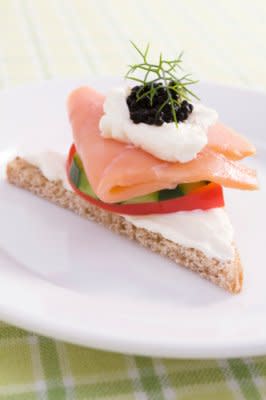The new Nordic diet: the next big weight loss trend?

Move over cavemenandMediterraneans, Vikings are the new diet gurus.
Claus Meyer, co-founder of the Danish restaurant Noma, twice named the best in the world, has been collaborating with nutrition experts to combat the obesity epidemic.
Meyer calls it The New Nordic Diet, but it's not exactly new. His food philosophy developed with obesity scientist Arne Astrup has been the subject of a $20 million research project over the past two years. Today, the early results of their work are in and it could mean a revolution in the diet industry.
In a 26-week study by Astrup and her team at theUniversity of Copenhagen, a group of overweight subjects managed to lose an average of 6.8 pounds after 12 weeks on the new Nordic diet. That was more than twice as much as dieters on standard portion-controlled meal plans lost.
"It's hard to pinpoint the individual ingredients that work but we can see that they lose more weight," said nutrition professor Thomas Larsen, who presented the study at the European Nutrition Conference last week.
As a whole, the diet contains some of the staples of classic cold-weather climate cooking: fish, nuts, legumes, fruits, berries, raw vegetables like cabbage, game meat, and Nordic starches, such as oats.
Like the much-touted Mediterranean diet, foods rich in omega fatty acids and anti-oxidants lead the pack, but with the Nordic diet the ingredients aren't reliant on a Mediterranean climate. Antioxidant-rich berries that thrive in northern parts of Europe (blueberries, cloudberries), greens like kale and cabbage that promote healthy blood flow, and lean game meats like elk and lamb are all part of the Danish foodie's plan for a healthier lifestyle.
Another staple of the diet: moderation not starvation. In his manifesto on the "principles of good flavors," Meyer offers these pointers that can be integrated into any meal plan, regardless of whether you're eating reindeer meat or turkey, cloudberries or blueberries.
Eat the food grown in your region
Meyer believes in eating locally, and getting creative with the food growing in your area in season. Not only does it challenge the cook to be creative but there's historical evidence that our species thrived on our regional foods long before we had processed starches in our pantry and produce shipped from across the globe.
Home-cooked meals are key
He suggests preparing simple meals from scratch for between 30 minutes to an hour a day, to help rethink diet as more of a lifestyle, or hobby of sorts. Adding a cultural, familial element to food, rather than a grab-and-go notion, can psychologically change the way people think about their diet.
Eat more side dishes
The more, the merrier and the healthier, according to Meyer. Side dishes are key to long-term healthy eating, so long as they're simply prepared vegetables. "Toss yesterday's leftover boiled or steamed vegetables with a little vinegar, capers, mustard, broad-leaf parsley and olive oil," he suggests. "Boil some red beets and put some quality salt, grated horseradish or mustard, and vinegar on the table. Use the pulse button on your food processor to mince the remainder of a portion of boiled legumes with some cumin, yogurt, lemon, mint, sugar and chili to create a cohesive and luscious thick mass, pour it into a bowl and add a splash of a high-quality virgin olive oil." It's the opposite of portion control, but he believes the lack of simplicity and the bevvy of flavors will lead to less binge-eating out boredom.
Replace sweetness with fat
Instead of dousing kale in oil or deep-frying your veggies, you can replace your buttery fixes with a hint of sugar-based condiments. "If you use balsamic vinegar or some other vinegar with sweet overtones to make a vinaigrette, you need far less oil than you would for a classic vinaigrette with white or red wine vinegar." He also suggests honey or molasses in place of fatty oils to bring out the flavors in bitter root veggies. Another tip from Meyer: Season leftover meet with a touch of vinegar instead of oil to bring out the juicy tenderness.
Season with more than just salt and pepper
Fresh herbs are crucial to Meyer's healthier philosophy, as are sweet and sour flavorings.
Everything from wine, to apple vinegars and lime juices, to yogurt all "offset the flavors of mild or even sweet ingredients such as most vegetables. Even grains, meat and fish can be enhanced with a dollop of yogurt or a splash of citrus instead of a slather of butter.
Your seasonings can also be sidesMeyer isn't big on sugary unnatural condiments like ketchup. Instead he suggests lining the side of your plate with flavor enhancers like pickled gherkins, red beets, tamarind, rhubarb,and even tomatoes. An all-natural substitute to a processed, sugary condiment isn't just healthier, it makes eating more interesting.
Meyer's principles are designed to prevent what he calls "relapses" into unhealthy binge eating. "You are not on a diet," he asserts in his manifesto. The idea of dieting, he believes, promotes a concept of deprivation, which isn't sustainable in the long term.
With his meal plan catching on worldwide (in the UK, there's a copycat cookbook, and Stanford University students recently got a preview of Meyer's principles during a health conference), Meyer is turning his efforts back to his country. He hopes to implement his principles in Danish schools, where a childhood obesity epidemic looms. In the meantime, you can read his diet manifesto here. And don't worry, there's always chicken, if you'd rather leave the reindeer for Santa.
Related:
6 diet trends you should never try
Can a diet cut your risk of chronic diseases?
The Mediterranean diet and your brain
Paleo diet: why cavemen do it better
